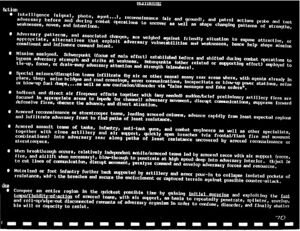Patterns of Conflict
| The works of |
| Works of John Boyd |
|---|
OODA WIKI Edition
Quantico Transcription
Boyd: I wanted to get enough in there so you could see, maybe get the message across.
[long pause as audience reads slide]
In fact, you can say this is sort of, part of your observation. Here’s your orientation. Here’s your decision. And here’s all this action taking place. Look at it that way. Think of it that way.
Looking at— I see that— you see that taking place then. I think most of you people are familiar with the schwerpunkt idea, aren’t you?
Audience: Yes, sir.
Boyd: This is my editorial, as I mentioned, the nebenpunkte. In fact, I laid it on [unintelligible]. He said we don’t have that. I said well, when you’re not in the schwerpunkt, what do you call it? And he couldn’t answer that. So I said then we’re going to call it the nebenpunkte. Using their own language against them.
In fact Hassen van Heuser [PH] really liked that. He said that’s pretty good. He’s a German, you know, the German attaché. The reason I want to want to bring in an idea, you want to play the cheng/chi game. You know, the nebenpunkte in a sense is the cheng. The schwerpunkt is the chi.
So you really want to set that up. Old Sun Tzu had a good idea there. That’s a little bit of my own editorial, invention.
And then these special teams they sent, they had, the Germans had what they called the Brandenburg Regiment. Anybody hear about that, the Brandenburg Regiment? And then later on, Skorzeny and his boys. And their game is to do this kind of stuff so the guys are all confused and soften up what you’re trying to achieve. It’s very successful.
And then your firepower, and of course it just keeps cascading on. Just pour it on. But all the time, strength against weakness. Strength against weakness. And all those levels are working.
And of course, the idea is very simple. The idea’s very simple. Very simple idea. Okay?
